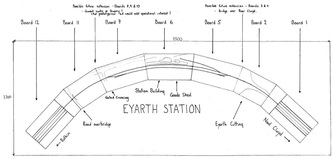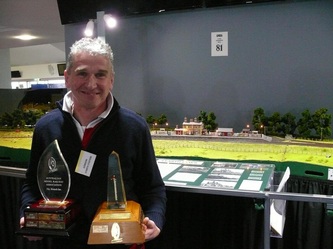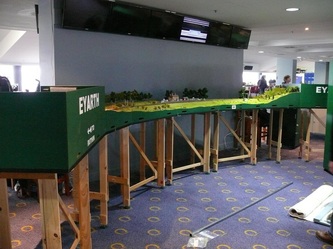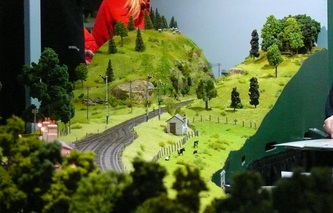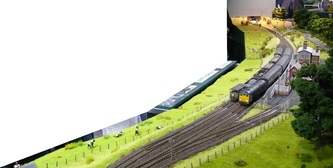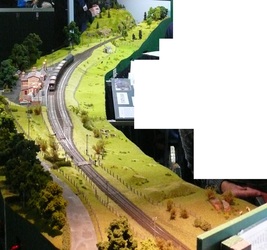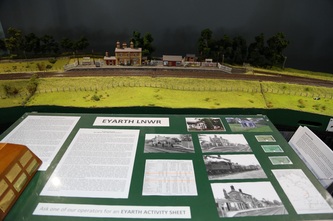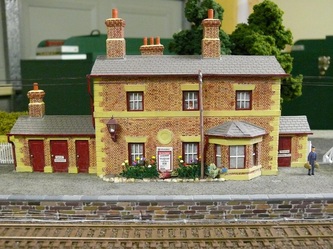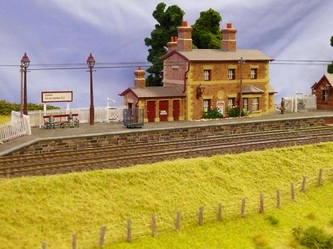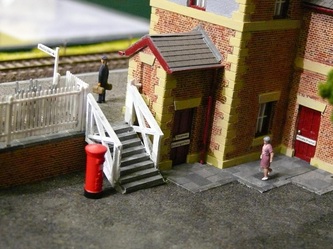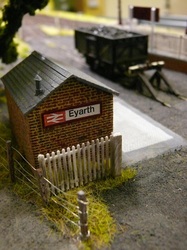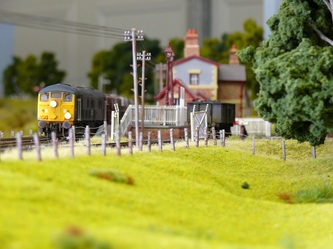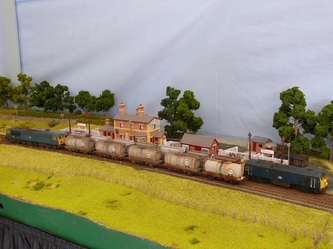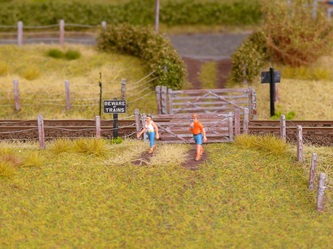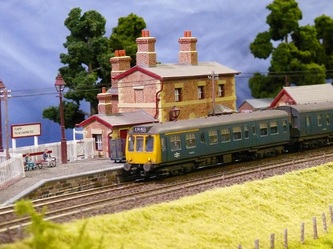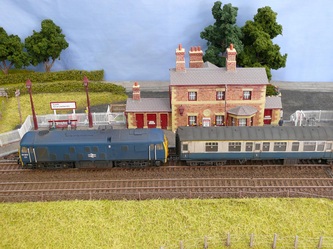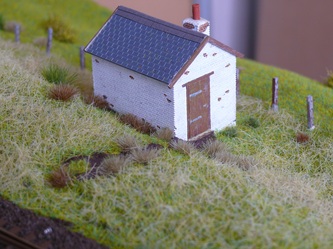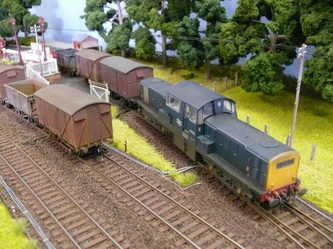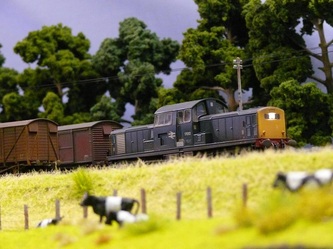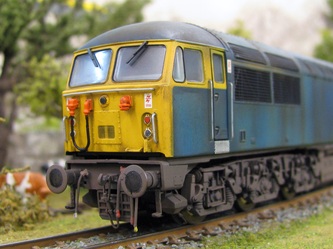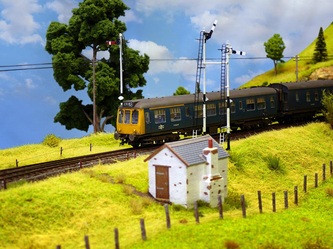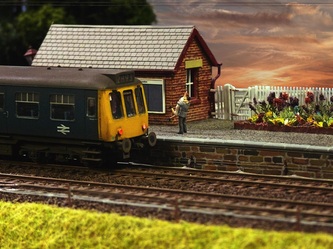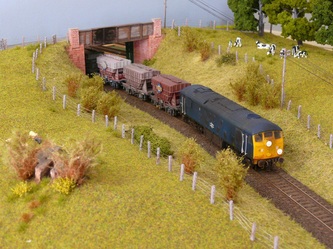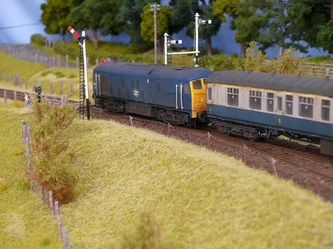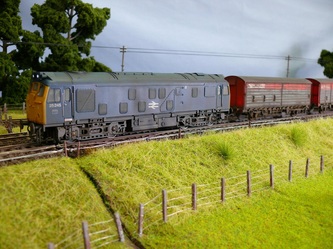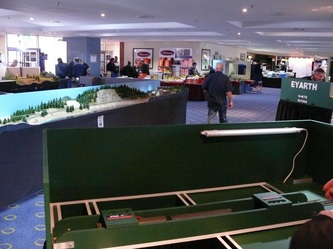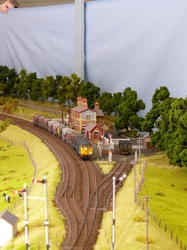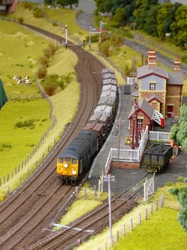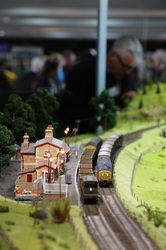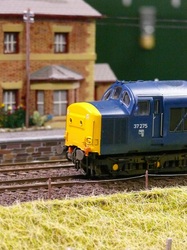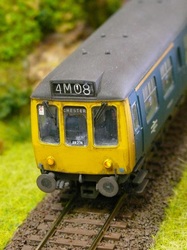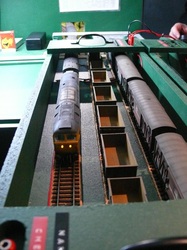Gordon B's Eyarth
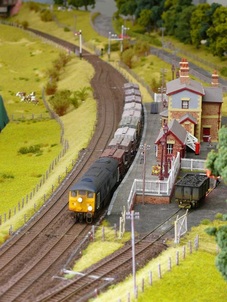
Eyarth is an attempt to model the station of that name in OO on the Denbigh, Ruthin & Corwen Railway in North Wales, as if it might have been had it survived into the British Railways Corporate Blue era (1970’s to early 1980’s).
This layout won both the Exhibitor's Award and Best Private Layout Award at the AMRA Exhibition at Caulfield, Melbourne, Australia, August 2013, and the Exhibitor's Award again in 2015.
It has also been shown at Stawell 2014 and Phillip Island 2015.
New - Ongoing Work - the Eyarth Cutting Extension
Prototype & History
Construction & Operation
Exhibitions & Acknowledgements
This layout won both the Exhibitor's Award and Best Private Layout Award at the AMRA Exhibition at Caulfield, Melbourne, Australia, August 2013, and the Exhibitor's Award again in 2015.
It has also been shown at Stawell 2014 and Phillip Island 2015.
New - Ongoing Work - the Eyarth Cutting Extension
Prototype & History
Construction & Operation
Exhibitions & Acknowledgements
Introduction
Eyarth is an attempt to model the station of that name on the Denbigh, Ruthin & Corwen Railway in North Wales, as if it might have been had it survived into the British Railways Corporate Blue era (1970’s to early 1980’s).
The DR&C ran through the southern part of the Vale of Clwyd and as its name suggests, it ran from Denbigh, (where it formed junctions with lines to Rhyl on the North Wales coastline and to Chester via Mold), through Ruthin to Corwen (where it formed a junction with the line from Ruabon to Barmouth, via Llangollen). It was single line throughout, with a number of passing loops at “token exchange points” along the line. Eyarth station served the nearby village of Llanfair Dyffryn Clwyd. This part of the line opened on 6 October 1864. Eyarth station closed to passenger traffic on 2 February 1953 and regular goods traffic ended on 30 April 1962, with the line formally closing on 1 March 1965. The station building, although much altered, is still in existence as a lovely Bed & Breakfast house.
I first found out about Eyarth in 1989 when I moved to North Wales and I fell in love with the station, the surrounding area and the image of what it must have been like when the line operated. Since then, I have always wanted to make a model of the station and this is now gradually coming to fruition. But I am too young to remember main line steam in the UK and diesel locomotives are my real passion in terms of motive power. Hence the idea of modelling the station as it might have been when diesels reigned supreme in the UK.
Huge amounts of modeller’s licence have been employed in constructing this layout. In particular, although Eyarth had a passing loop for most of its life, it was never a token exchange point and so trains would rarely, if ever, have passed there. To make for more operational interest, I have assumed that somehow it acquired this status. There are other what-ifs and might-have-beens as explained in the “Why Might Eyarth Have Survived” section but modeller’s licence has also taken other forms. . Whilst I lived in North Wales I did quite a lot of research on the station and have a quite large library of photographs and plans. But it is only when you begin to model a real station that you realise how much you DON’T know about it. Considerable educated guesswork has therefore been employed to fill in the gaps. Other assumptions have just been made to cover up my limited modelling skills!
For photos of the station, both when it was in use and now, as well as some more history, maps and timetables, go to www.disused-stations.org.uk/e/eyarth
Outline of the Layout
Eyarth is an end-to-end (or “fiddle yard to fiddle yard”) layout. There are moveable storage cassettes at each end and the single line runs from them to a passing loop in the centre of the layout. There is also one siding that allows limited shunting activity. The idea is that trains are driven from the each fiddle yard into the loop, where they pass and are then driven off scene to the other fiddle yard. Each cassette generally holds three trains and once all trains on a cassette have been driven to the opposite end of the layout, cassettes are turned around and trains are driven back to their original location.
To be operated efficiently, the layout requires three operators, one at each end to drive trains and one in the centre to change the points and signals.
The layout is built as a quarter circle with a radius of approximately 4.2 metres. There were two main reasons for adopting this configuration:
The layout is being built in my 5m x 5m garage. A straight layout would have given a maximum length of 5m but a quarter circle gives about 7.5m run length in the same space.
The real Eyarth was laid on a gentle curve and I wanted to replicate that. A quarter circle gives a much gentler curve than a full or half circle.
It has been pointed out to me that an added benefit of this design is that it tends to “draw you in” to the layout as you view it but that is far too deep a concept for me to have thought of myself!
Due to space constraints, cassette lengths are limited to 1 metre. Although this limits train length to locomotive and between 4 and 7 wagons depending on their wheelbase, it also limits the length of the required passing loop and results in the scenic section having good proportions, relative to the loop and the single track approaches at each end.
The scenic breaks at each end of the layout are based on structures that actually existed. At the northern (Ruthin) end, the line enters the scenic section under the bridge that carried the road to Ffynogion Farm. At the Southern (Nant Clwyd) end, it enters through Eyarth Cutting. In both cases however (and particularly in the case of Eyarth Cutting) these features were much further away from the station than I have depicted.
The ultimate aim for me is to bring the layout to a state of completion and a quality level that will allow it to be exhibited publicly. That day has not yet arrived but at time of writing (May 2013) I am hoping that I will be able to take it to the Australian Model Railway Association Exhibition in August 2013. When the day comes, I am aware that the layout will perhaps have less movement of trains than a circular layout. I am therefore also building information boards with photographs of the real line, history and background details to try and maintain some interest for viewers between the passage of trains.
In order to make the layout portable, stage 1 is constructed from 7 separate boards of approximately 1 metre in length. The boards are not rectangular but are parallelograms, with the join between each board creating an angle of 15 degrees (the layout plan explains it better). Of the 7 boards, two are for the fiddle yards and 5 are scenic. Planning included the provision to add further boards in the future as shown in the layout plan.
If you include initial the concept and preliminary planning, the layout has existed in my head for many years. But the first timber was actually cut on 26th January 2009. It took me until about two weeks before the AMRA Exhibition in August 2013 before I felt the layout was ready. So that’s 4 ½ years in total to build the layout.
A layout is never 100% complete however and there is more work to be done. The benefits of DCC control of my locomotives have not been fully exploited and I would like to fiddle with the settings to get more prototypical running from them. I would also like to move away from proprietary couplings to something that looks a little more authentic. And the layout was built from the start with extensions in mind. I’d like to add a section between the station and Eyarth Cutting that will include the bridge where the line crosses the River Clwyd. I have another two boards in my mind.....
I’ll provide further updates on the progress of these enhancements.
Eyarth is an attempt to model the station of that name on the Denbigh, Ruthin & Corwen Railway in North Wales, as if it might have been had it survived into the British Railways Corporate Blue era (1970’s to early 1980’s).
The DR&C ran through the southern part of the Vale of Clwyd and as its name suggests, it ran from Denbigh, (where it formed junctions with lines to Rhyl on the North Wales coastline and to Chester via Mold), through Ruthin to Corwen (where it formed a junction with the line from Ruabon to Barmouth, via Llangollen). It was single line throughout, with a number of passing loops at “token exchange points” along the line. Eyarth station served the nearby village of Llanfair Dyffryn Clwyd. This part of the line opened on 6 October 1864. Eyarth station closed to passenger traffic on 2 February 1953 and regular goods traffic ended on 30 April 1962, with the line formally closing on 1 March 1965. The station building, although much altered, is still in existence as a lovely Bed & Breakfast house.
I first found out about Eyarth in 1989 when I moved to North Wales and I fell in love with the station, the surrounding area and the image of what it must have been like when the line operated. Since then, I have always wanted to make a model of the station and this is now gradually coming to fruition. But I am too young to remember main line steam in the UK and diesel locomotives are my real passion in terms of motive power. Hence the idea of modelling the station as it might have been when diesels reigned supreme in the UK.
Huge amounts of modeller’s licence have been employed in constructing this layout. In particular, although Eyarth had a passing loop for most of its life, it was never a token exchange point and so trains would rarely, if ever, have passed there. To make for more operational interest, I have assumed that somehow it acquired this status. There are other what-ifs and might-have-beens as explained in the “Why Might Eyarth Have Survived” section but modeller’s licence has also taken other forms. . Whilst I lived in North Wales I did quite a lot of research on the station and have a quite large library of photographs and plans. But it is only when you begin to model a real station that you realise how much you DON’T know about it. Considerable educated guesswork has therefore been employed to fill in the gaps. Other assumptions have just been made to cover up my limited modelling skills!
For photos of the station, both when it was in use and now, as well as some more history, maps and timetables, go to www.disused-stations.org.uk/e/eyarth
Outline of the Layout
Eyarth is an end-to-end (or “fiddle yard to fiddle yard”) layout. There are moveable storage cassettes at each end and the single line runs from them to a passing loop in the centre of the layout. There is also one siding that allows limited shunting activity. The idea is that trains are driven from the each fiddle yard into the loop, where they pass and are then driven off scene to the other fiddle yard. Each cassette generally holds three trains and once all trains on a cassette have been driven to the opposite end of the layout, cassettes are turned around and trains are driven back to their original location.
To be operated efficiently, the layout requires three operators, one at each end to drive trains and one in the centre to change the points and signals.
The layout is built as a quarter circle with a radius of approximately 4.2 metres. There were two main reasons for adopting this configuration:
The layout is being built in my 5m x 5m garage. A straight layout would have given a maximum length of 5m but a quarter circle gives about 7.5m run length in the same space.
The real Eyarth was laid on a gentle curve and I wanted to replicate that. A quarter circle gives a much gentler curve than a full or half circle.
It has been pointed out to me that an added benefit of this design is that it tends to “draw you in” to the layout as you view it but that is far too deep a concept for me to have thought of myself!
Due to space constraints, cassette lengths are limited to 1 metre. Although this limits train length to locomotive and between 4 and 7 wagons depending on their wheelbase, it also limits the length of the required passing loop and results in the scenic section having good proportions, relative to the loop and the single track approaches at each end.
The scenic breaks at each end of the layout are based on structures that actually existed. At the northern (Ruthin) end, the line enters the scenic section under the bridge that carried the road to Ffynogion Farm. At the Southern (Nant Clwyd) end, it enters through Eyarth Cutting. In both cases however (and particularly in the case of Eyarth Cutting) these features were much further away from the station than I have depicted.
The ultimate aim for me is to bring the layout to a state of completion and a quality level that will allow it to be exhibited publicly. That day has not yet arrived but at time of writing (May 2013) I am hoping that I will be able to take it to the Australian Model Railway Association Exhibition in August 2013. When the day comes, I am aware that the layout will perhaps have less movement of trains than a circular layout. I am therefore also building information boards with photographs of the real line, history and background details to try and maintain some interest for viewers between the passage of trains.
In order to make the layout portable, stage 1 is constructed from 7 separate boards of approximately 1 metre in length. The boards are not rectangular but are parallelograms, with the join between each board creating an angle of 15 degrees (the layout plan explains it better). Of the 7 boards, two are for the fiddle yards and 5 are scenic. Planning included the provision to add further boards in the future as shown in the layout plan.
If you include initial the concept and preliminary planning, the layout has existed in my head for many years. But the first timber was actually cut on 26th January 2009. It took me until about two weeks before the AMRA Exhibition in August 2013 before I felt the layout was ready. So that’s 4 ½ years in total to build the layout.
A layout is never 100% complete however and there is more work to be done. The benefits of DCC control of my locomotives have not been fully exploited and I would like to fiddle with the settings to get more prototypical running from them. I would also like to move away from proprietary couplings to something that looks a little more authentic. And the layout was built from the start with extensions in mind. I’d like to add a section between the station and Eyarth Cutting that will include the bridge where the line crosses the River Clwyd. I have another two boards in my mind.....
I’ll provide further updates on the progress of these enhancements.

